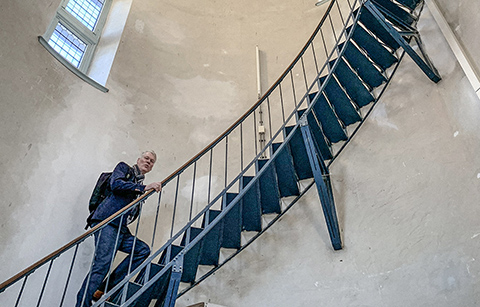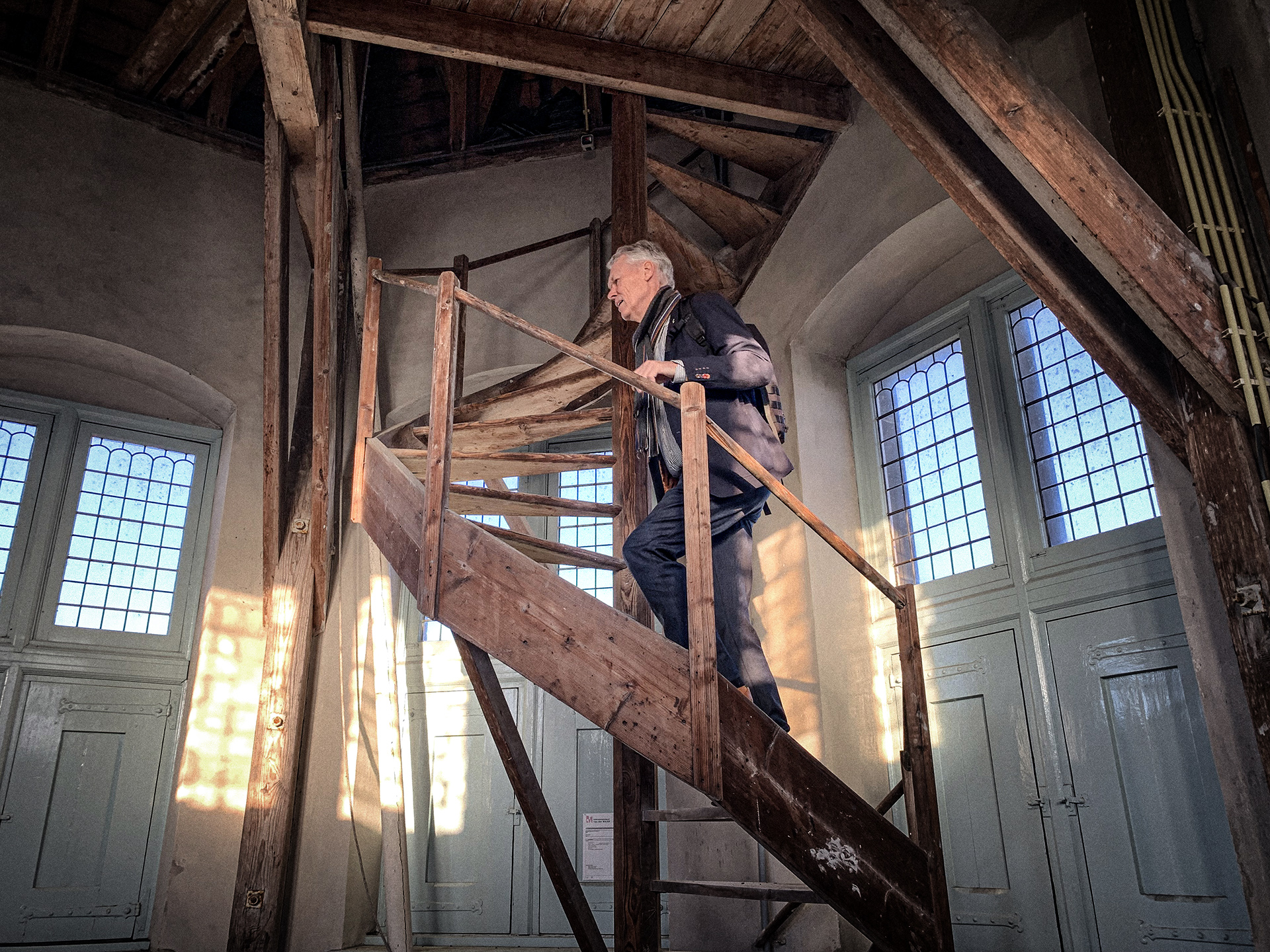
Our carillonneur says goodbye
A towering
career
‘Maybe I’m just retiring at the height of my career’, says Auke de Boer, laughing heartily. The UG’s carillonneur wouldn’t have minded staying on a few more years. ‘But you can’t fight retirement. It’s time to let the next generation take over.’
Twenty-five years ago, he was the first person to have the opportunity to play the bells of the Academy building on a weekly basis. ‘The bells had only just been installed’, says De Boer. Hendrik de Waard, chair of the UG Representation Fund, had come up with the idea.
Empty
The Fund celebrated its one hundredth anniversary in 1996 and the Academy building’s tower was empty. ‘De Waard loved bells and he liked the idea of using the tower and donating a carillon to the university.’ De Boer was the first person to ‘serenade the city centre’ from that tower.
In talking to the carillonneur, it’s clear that he’s passionate about the bells. He effortlessly takes his listeners on a journey of the history of the quintessentially Dutch instrument.
Science explores the limits of what we know, and that’s something I’ve tried to do with my music, as well
‘The first mention of a Groningen carillonneur is made in 1525, but it’s possible one existed long before that. The people listening to the bells in the Middle Ages were hearing the exact same thing we hear today. Isn’t that amazing?’
Pop songs
The bells may sound the same, but people from the Middle Ages wouldn’t have heard pop songs coming from the tower. ‘That’s one of the great things about being a university carillonneur’, he says. ‘I have a lot more freedom than at my job as the city carillonneur at the Martini church. Science explores the limits of what we know, and that’s something I’ve tried to do with my music, as well.’
De Boer didn’t just play ‘safe classical music’, but he also went looking for modern songs to play. Songs that students, staff, and others in the city centre would recognise. Popular songs from the past fifty years, as well as traditional songs from various countries. ‘One time, there was a conference on Japan, so I played a lot of Japanese songs’, he says.
‘I wanted to give my listeners the full experience’, he says. ‘That’s what I wanted to give the students, too. Especially the international students, to give them a taste of home. It’s wonderful when, say, a student from Mexico comes up and tells me I managed to do that’, says De Boer.
Georgian news
A Georgian student once approached him and requested a specific Georgian song. ‘I played it and it was even on the Georgian news’, he says, laughing. In fact, his effort was appreciated so much that the Georgian embassy sent him a present for the holidays that year. ‘They gave me a little music box from Georgia as a decoration for doing something of great merit for their country.’
If you go too quickly, you’re exhausted halfway up
He doesn’t sound sad, but it’s clear De Boer will miss his weekly trip to the university. Picking up the key from the reception desk, making his way to the Honours College, and disappearing up the tower through a door in a random office. Mounting first the wooden steps to the hollow, where a spiral staircase leads all the way up to the top of the tower.
‘It’s 250 steps’, De Boer says, taking them at a slow, even pace. The carillonneur’s pace, he calls it. ‘If you go too quickly, you’re exhausted halfway up.’

Broom
At the top, there’s a slight buzzing. ‘Ah, it looks like the floor is dirty again’, he says, smiling. The ground is covered with small flies, some dead, some dying. He grabs a broom from where it’s leaned against a cupboard. ‘I sweep up every now and then.’ He points to a sizeable black pile in the corner. ‘That’s thirty years of dead flies right there.’
He’s got a little more to go. In order to reach the bells, he needs to climb a set of wooden steps up to a small wooden loft. Finally, another ladder, which leads to a small room Just big enough to house the keyboard, the long wooden keys that operate the bells, and himself.
‘I’ve always enjoyed this job. One reason is the interaction with the university community.’ He may have spent all those years up in the tower alone, he’s always felt a connection with his listeners.
Big shots
‘Like the neighbours who’d ask me if the bells were broken when I forgot to switch on the automation’, he says. Or when big shots came to visit and he’d ask them if they had any requests for him. Any and all students that expressed an interest in seeing the bells could come up.
There has to be a foundation there, something that makes the students and the neighbours feel that connection, too
That’s the way to go about it, feels. ‘I don’t want to just be a work horse, just playing my songs whether people like it or not. There has to be a foundation there, something that makes the students and the neighbours feel that connection, too.’
That foundation needs to be sturdy, De Boer says. He keeps it that way by forging a connection with his community and passing on the love for the bells, as well as through personal development.
Yale and Harvard
‘I regularly visited campuses in America’, he says. ‘Like Yale and Harvard. They have these big campuses with a tower right in the middle. I’d visit colleagues to see how they worked and to tell them more about our set-up here.’
He was also a welcomed guest at various conferences and meetings. ‘A few years ago, I went to Brussels to give a lecture to the Senate. The Belgian carillonneurs were put on the UNESCO heritage list and I was invited to give a talk on the culture, the instrument, and the job.’
His eyes twinkle when he talks about his adventures abroad. ‘Sure, it’s a profession you do on your own, but it’s definitely not lonely.’
Leaving the bells
Tuesday, December 21, between 3 and 4 p.m., will mark his last time as the university’s carillonneur, but that doesn’t mean he’s leaving the bells behind for good. Perhaps now is the time to write an atlas of the bells. ‘An overview of all the bells in the province. There’s already one on Groningen, but not on Friesland.’
He might also have to time to collaborate on some special projects with the new UG carillonneur. ‘We could do improvisation, or have live musician playing along with the bells’, he muses. ‘I definitely won’t be sitting around doing nothing.’